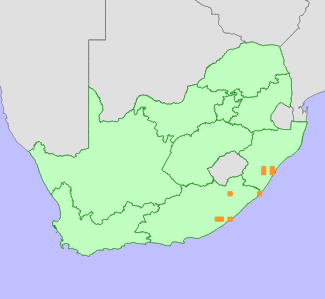|
Scientific Name | Drimia echinostachya (Baker) Eggli & N.R.Crouch |
Higher Classification | Monocotyledons |
Family | HYACINTHACEAE |
Synonyms | Drimia cooperi (Baker) Benth. ex Baker, Ornithogalum cooperi Baker, Urginea echinostachys Baker |
National Status |
Status and Criteria | Vulnerable A2ad; C2a(i) |
Assessment Date | 2008/03/10 |
Assessor(s) | V.L. Williams & N.R. Crouch |
Justification | This species is estimated to have experienced over 30% decline in the last 30 years due to habitat loss and muthi collection. The subpopulations are fragmented and are suspected to occur in fewer than 10 locations. The population size is estimated to be less than 10 000 mature individuals, and the number of mature individuals that have been recorded in a subpopulation is less than 100. The generation length is suspected to be 20 years. It is therefore listed as Vulnerable under criteria A and C. |
Distribution |
Endemism | South African endemic |
Provincial distribution | Eastern Cape, KwaZulu-Natal |
Range | This species is endemic to the Eastern Cape and KwaZulu Natal provinces of South Africa, where it occurs in Umtamvuna Nature Reserve, near Komga and in Kentani. |
Habitat and Ecology |
Major system | Terrestrial |
Major habitats | Bhisho Thornveld, Eastern Valley Bushveld, KwaZulu-Natal Hinterland Thornveld, Midlands Mistbelt Grassland, Dry Coast Hinterland Grassland, East Griqualand Grassland, Amathole Montane Grassland, Scarp Forest, Pondoland-Ugu Sandstone Coastal Sourveld, KwaZulu-Natal Coastal Belt Grassland |
Description | It grows on grassy hills. |
Threats |
| This species is a distinctive salmon-coloured bulb that is threatened by muthi harvesting and habitat loss. The species was first recorded in Durban's Warwick market in December 2004 and was reportedly harvested in the Eastern Cape (N.R. Crouch, pers. comm., 2008). According to Neil, he has only ever seen it in the market twice in the 13 years he has been visiting the markets, and the first time was in 2004. More recently, V.J. Brueton bought five specimens from the Warwick market in January 2008 (pers. comm.). The harvesting locality mentioned by the trader supports the evidence of the known localities. Harvesting of the bulbs for the traditional medicine trade is expected to continue if harvesters find a subpopulation. The bulbs are not massively clumped, and traders would probably find 5-10 bulbs in an area which they are more than likely remove.
The areas of suitable habitat, especially in the Oribi/Pietermaritzburg area are suspected to have declined by at least 30% in the last 90 years due to habitat transformation (N.R. Crouch, pers. comm., 2008). According to Crouch, "between these grassland localities (Oribi and Hayfields) the suburb of Scottsville has expanded and nearly completely transformed the intervening area. I expect that it occurred there once but has disappeared over the last 90 years". The species was never recorded much before land was transformed (e.g. sugar cane plantations and housing), hence it is difficult to say how abundant it was before. |
Population |
The subpopulations are fragmented, and it is suspected that there are less than 10 remaining locations. Furthermore, the number of mature individuals is suspected to be less than 10 000, and no more than 100 individuals has been seen in a subpopulation.
|
Population trend | Decreasing |
Assessment History |
Taxon assessed |
Status and Criteria |
Citation/Red List version | | Drimia echinostachya (Baker) Eggli & N.R.Crouch | VU A2ad; C2a(i) | 2014.1 | | Drimia cooperi (Baker) Baker | VU A2ad; C2a(i) | Raimondo et al. (2009) | |
Bibliography |
Crouch, N.R., Williams, V.L., Edwards, T.J. and Brueton, V.J. 2010. Notes on African plants: Hyacinthaceae: Drimia cooperi in KwaZulu-Natal, and the ethnomedicinal trade. Bothalia 40(1):75-78.
Eggli, U. and Crouch, N.R. 2012. HYACINTHACEAE: Drimia echinostachya, correcting a nomenclatural oversight. Bothalia 42(1):43-66.
Jessop, J.P. 1977. Studies in the bulbous Liliaceae in South Africa: 7. The taxonomy of Drimia and certain allied genera. Journal of South African Botany 43(4):265-319.
Raimondo, D., von Staden, L., Foden, W., Victor, J.E., Helme, N.A., Turner, R.C., Kamundi, D.A. and Manyama, P.A. 2009. Red List of South African Plants. Strelitzia 25. South African National Biodiversity Institute, Pretoria.
|
Citation |
| Williams, V.L. & Crouch, N.R. 2008. Drimia echinostachya (Baker) Eggli & N.R.Crouch. National Assessment: Red List of South African Plants version 2024.1. Accessed on 2025/12/01 |
 Comment on this assessment
Comment on this assessment


